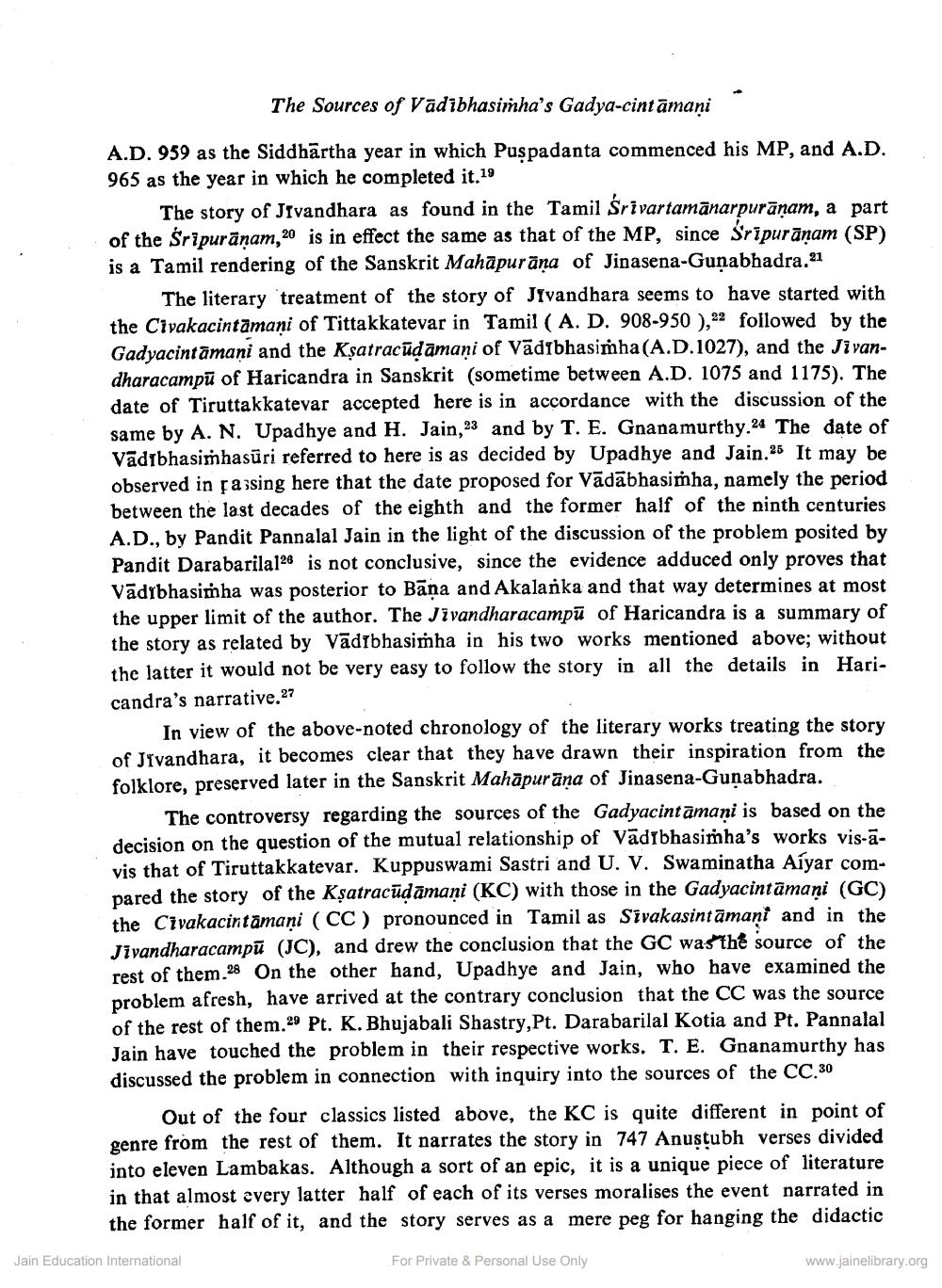________________
The Sources of Vadibhasimha's Gadya-cintāmaņi
A.D. 959 as the Siddhartha year in which Puspadanta commenced his MP, and A.D. 965 as the year in which he completed it.19
The story of Jivandhara as found in the Tamil Srivartamānarpurānam, a part of the Sripurānam,20 is in effect the same as that of the MP, since Śrīpurānam (SP) is a Tamil rendering of the Sanskrit Mahāpurāņa of Jinasena-Gunabhadra 21
The literary treatment of the story of Jyvandhara seems to have started with the Civakacintamani of Tittakkatevar in Tamil ( A. D. 908-950),22 followed by the Gadyacintāmani and the Kşatracüdāmaņi of Vādıbhasimha(A.D. 1027), and the Jivandharacampū of Haricandra in Sanskrit (sometime between A.D. 1075 and 1175). The date of Tiruttakkatevar accepted here is in accordance with the discussion of the same by A. N. Upadhye and H. Jain,23 and by T. E. Gnanamurthy.24 The date of Vadıbhasimhasűri referred to here is as decided by Upadhye and Jain.25 It may be observed in saising here that the date proposed for Vādābhasimha, namely the period between the last decades of the eighth and the former half of the ninth centuries A.D., by Pandit Pannalal Jain in the light of the discussion of the problem posited by Pandit Darabarila12e is not conclusive, since the evidence adduced only proves that Vādıbhasimha was posterior to Bāna and Akalanka and that way determines at most the upper limit of the author. The Jivandharacampū of Haricandra is a summary of the story as related by Vādibhasimha in his two works mentioned above; without the latter it would not be very easy to follow the story in all the details in Haricandra's narrative. 27
In view of the above-noted chronology of the literary works treating the story of Jivandhara, it becomes clear that they have drawn their inspiration from the folklore, preserved later in the Sanskrit Mahāpurāna of Jinasena-Gunabhadra.
The controversy regarding the sources of the Gadyacintamani is based on the decision on the question of the mutual relationship of Vädıbhasisha's works vis-avis that of Tiruttakkatevar. Kuppuswami Sastri and U. V. Swaminatha Aiyar compared the story of the Kșatracūdāmaņi (KC) with those in the Gadyacintāmaņi (GC) the Civakacintāmaņi (CC) pronounced in Tamil as Sivakasintāmaņi and in the Jivandharacampū (JC), and drew the conclusion that the GC was the source of the rest of them.28 On the other hand, Upadhye and Jain, who have examined the problem afresh, have arrived at the contrary conclusion that the CC was the source of the rest of them.29 Pt. K. Bhujabali Shastry, Pt. Darabarilal Kotia and Pt. Pannalal Jain have touched the problem in their respective works. T. E. Gnanamurthy has discussed the problem in connection with inquiry into the sources of the CC.30
Out of the four classics listed above, the KC is quite different in point of genre from the rest of them. It narrates the story in 747 Anustubh verses divided into eleven Lambakas. Although a sort of an epic, it is a unique piece of literature in that almost every latter half of each of its verses moralises the event narrated in the former half of it, and the story serves as a mere peg for hanging the didactic
Jain Education International
For Private & Personal Use Only
www.jainelibrary.org




